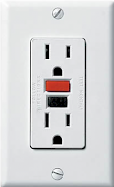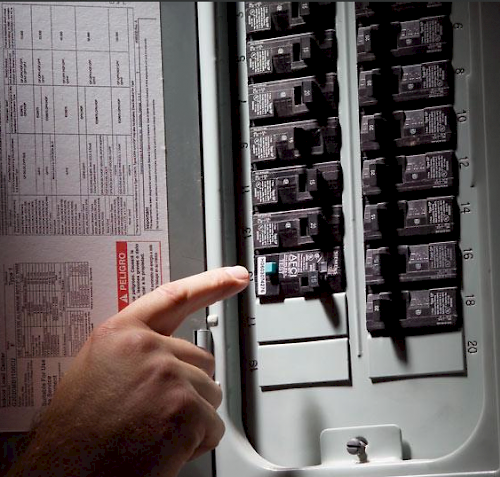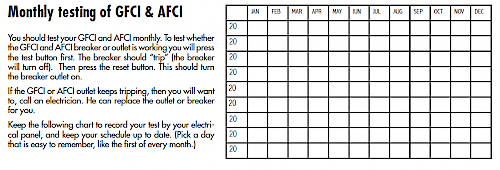Testing your Arc/GFCI can prevent electrical fires and shocks
 Above, at the electrical panel, for testing the Arc Fault. At right, a typical GFCI you will find in bathrooms and kitchens
Above, at the electrical panel, for testing the Arc Fault. At right, a typical GFCI you will find in bathrooms and kitchens
Here's a "how to" and testing schedule for you to download and use. Put it by your electrical panel, (tape it to the panel) and use it monthly. Pick a day that's easy to remember, like the first of every month.
For easy reference for testing, click on the image to enlarge, and then print
Electrical fires are one of the most common disasters that can happen to a home. Fire damage or even complete destruction and potential loss of life. Over the last 30 years or so, one method of reducing electrical fires is by using Arc Fault Circuit Interrupters, or AFCI's. TO reduce shock in wet areas we have GFCI's.
Manufacturers require monthly testing and documentation of these types of outlets on a monthly basis to ensure proper operation. They are extremely susceptible to damage from lightning or other types of power surges. More recently, AFCI's have become popular installations in homes as a means of reducing the chances of damage by electrical fire in bedrooms.
You will find Arc Fault Circuit Interrupters Breakers attached to the bedroom plugs.
You will find Ground Fault Circuit Interrupters Breakers and receptacles attached to circuits for bathroom, exterior and kitchen plugs.
Why are they important?
An arc occurs when electrical wiring becomes overheated or damaged. One type can be found on the outlet itself and is designed to immediately cut power to it if a problem occurs. In a similar way, the Branch AFCI is designed to replace typical circuit breakers and can shut down power before a fire has a chance to start. Instead of simply throwing a circuit like a traditional circuit breaker would do, these newer types can detect a problem long before it would have otherwise been recognized and all power can be shut down virtually instantaneously. In addition, some homes may utilize both the Branch AFCI and the outlet version in conjunction with each other.
But, it's important to note that the testing of these outlets/breakers are done on a monthly basis to ensure that they are in good operating condition. I test all of mine monthly. Replacement of an ARC/GFCI is a simple DYI, or a few minutes of an electrician's time.
These devices are your best friends when it comes to the electricity in your home. We're speaking circuit breakers of course...
You know how you've been told not to overload an outlet, but yet you still have six surge protectors strung together with who knows how many things plugged into them? Fuses and circuit breakers are the watchmen of the current. When you demand too much from a outlet, one of two things can happen.
- You "trip" the breaker.
- That wire that is only meant to carry 15 amps of current has now gotten so hot it has melted the plastic insulation jacket off, and the wires are touching. And a fire has started.
Arc-Fault Breakers are the newest style of breaker to be developed. They work on a different principle than the other two styles of breakers. The arc fault circuit breaker continuously monitors the shape of the sine wave of the electricity passing through the AFCI breaker. If the sine wave is uneven or jagged, it can be an indicator of a sparking condition somewhere down the line. The AFCI uses a very simple computer chip that constantly checks for a sparking condition between the hot wire and the neutral wire. It also checks for a high resistance or over-heating condition in either the out-going hot wire or the returning neutral wire. Generally it checks for any sputtering, sparking or overheating condition that might indicate a loose or overheating connection.
A GFCI Breaker
Notice the "TEST" button, much like what you will find on a GFCI wall outlet. GFCI circuit breakers are designed to protect against ground faults of 6 mA or more.


